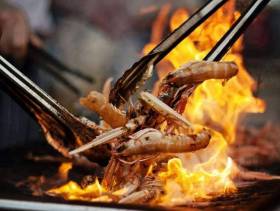Displaying items by tag: Seafood Festivals
#SeaFoodFest - Linking in the St Patrick's Weekend is the Dublin Bay Prawn Festival (17-19 March) which offers three days filled to the brim with fun, food and delights to suit all.
The festival located in the apt setting of the fishing harbour village easily accessible by DART, offers many award winning restaurants along the West Pier and the on the food village’s main street.
So whatever way you like your prawns – barbecued, whole, shelled, fried, skewered, marinated, sauced – there’s no excuse not to indulge.
In addition there is the market offering local foods, fish filleting & fishery skills and a programme of family fun.
Neven Maguire will also be on hand in the food village as he will have live cooking demonstrations for all those budding cooks out there.
Why not as part of your day out visiting Howth explore offshore given the harbour’s wonderful backdrop of the island of Ireland’s Eye. The island which has sandy beaches, bird colonies and a ruins of monastery.
Ireland's Eye can be easily reached and explored by taking an excursion boat operated by Ireland’s Eye Ferries. They provide landing trips to Ireland's Eye and also to boat trips around the island. They run from 10:30am to 5pm from the West Pier. Weather permitting, the trips operate daily.
In addition why not take in the scenic coastal walks on Howth Peninsula which affords panoramic views. Firstly are those views overlooking Howth Harbour and to Ireland’s Eye, Lambay Island and further northwards to the Mountains of Mourne.
There are also in the opposite direction wonderful sweeping views facing south across the broad expanse of Dublin Bay and the peninsula's iconic landmark of the Baily Lighthouse perched above the sea. Beyond the bay this spectator vista is framed with the backdrop of the rolling hills and mountains of Wicklow.
























































